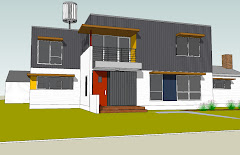
I was all set to do an update on the HAUS' energy use and green roof performance this week but have learned that the HAUS has won one of the coveted Evergreen Awards from Eco-Structure magazine. The awards will be presented at GreenBuild in Phoenix on November 11th.
The HAUS has previously won an AIA HOME Award and and AIA residential RAVE Award and is all set to strut its stuff on Discovery/Planet Green's "World Greenest Homes" cable tv show sometime this Fall (still waiting for an exact date from the network).

To repeat a portion of a previous rant relating to awards and the like. We do not spend our time designing in the hopes or intent of winning an award. Rather, we spend our time looking for creative, practical, sensible and simple solutions to problems. We like to solve problems through design and deep thinking so that they may be more effective, environmentally responsible, economically viable and beautiful. Receiving awards are splendid forms of recognition for these efforts - but they do not change our approach- which is simply- to do good work and to do no harm. We like the awards. They make us feel good. We like our work. It makes us feel good too.
For a link to the Evergreen Awards articles - please follow this link







